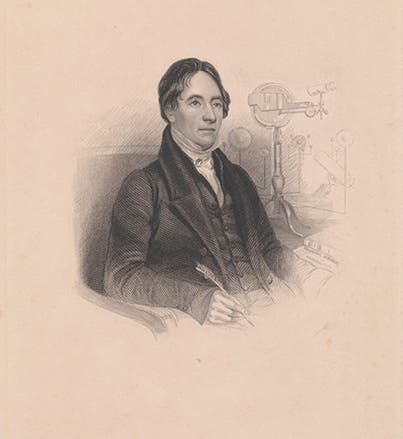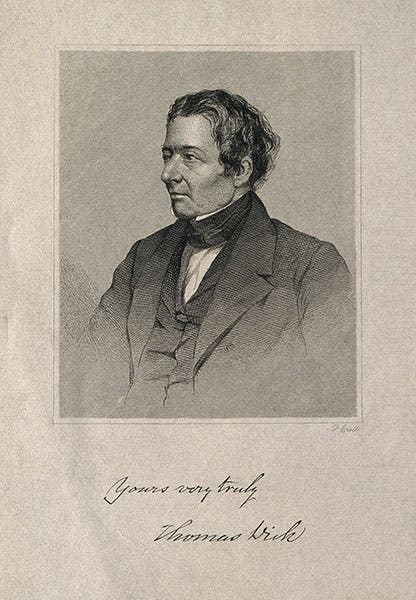Scientist of the Day - Thomas Dick
Thomas Dick, a Scottish evangelical minister and popular science author, died July 29, 1857, at the age of 83. Dick had a childhood passion for astronomy, building his own telescope and using it to observe the planets. Christian faith, however, was an even greater obsession, and he pursued a divinity degree from Edinburgh University, became an ordained minister, acquired a wife, and was off on a path shared by thousands of others. Then in 1804, Dick fathered a child in an adulterous relationship with a servant, was found out, lost his wife, and was defrocked and excommunicated. Things could hardly have been worse for the young man. Within twenty years, however, Dick had completely refashioned himself as a natural theologian and a writer on popular astronomy. Many authors of popular astronomical books left religion out of the story, but Dick was convinced that knowledge of nature was always compatible with scripture, and that there was no better way to appreciate the wisdom and providence of God than by studying his creation. Dick's first major book was one of his most successful, The Christian Philosopher, or the Connection of Science with Religion (1823), and it re-established his reputation. His astronomy books included Celestial Scenery, or the Wonders of Heavens Displayed, Illustrating the Perfection of Deity and the Plurality of Worlds (1837), and The Sidereal Heavens (1840).
Dick was a strong believer in the plurality of worlds, as the subtitle of his Celestial Scenery indicates; he thought that a universe filled with intelligent souls was far grander, and far more characteristic of God's benevolence, than a universe in which life is restricted to our puny planet. Quite a number of 19th century Victorians believed in a plurality of worlds, but not too many of them were evangelical Christians.
Given the growth of evangelical Christianity in the United States in the 19th century, it is not surprising that Dick's works were incredibly popular in the U.S. and went through dozens of American editions. A recent book-length study of Dick by William Astore reveals that Dick’s books were especially popular with mechanic’s institutes, Sunday schools, lecture circuits, and Chautauquas. Given the lack of international copyright laws, Dick did not benefit financially from his popularity in the colonies, and he died in relative poverty in 1857, supported in his last years by donations from friends and townsfolk. There are two engraved portraits of Dick, one showing him in his middle years, surrounded by astronomical instruments, and the other showing an older man, presumably wiser. It is always satisfying to have two images of lesser historical figures like Dick, because when they look like the same individual, but at different ages, then we feel more confident that we are dealing here with a real historical person.
We have no works at all by Thomas Dick in our Library, which is a little surprising. One can understand why earlier acquisitions librarians might have shied away from a book called The Christian Philosopher, and maybe even one titled Celestial Scenery. But we have a very strong collection in natural theology, including books such as John Ray’s The Wisdom of God (1693), William Paley’s Natural Theology (1802), and a complete set of the Bridgewater Treatises (1833-36), and we also have strong holdings in Victorian popular science, so adding a few Dick titles to our holdings would seem like a reasonable idea. We will work on it.
Dr. William B. Ashworth, Jr., Consultant for the History of Science, Linda Hall Library and Associate Professor, Department of History, University of Missouri-Kansas City. Comments or corrections are welcome; please direct to ashworthw@umkc.edu.





![“Aurora Borealis,” hand-colored wood engraving by Josiah Wood Whymper, [Natural Phenomena], plate 2, 1846 (Linda Hall Library)](https://assets-us-01.kc-usercontent.com:443/9dd25524-761a-000d-d79f-86a5086d4774/0245ffcb-b70c-477c-8792-0a73ebd54eb2/Whymper%2011.jpg?w=210&h=210&auto=format&fit=crop)

